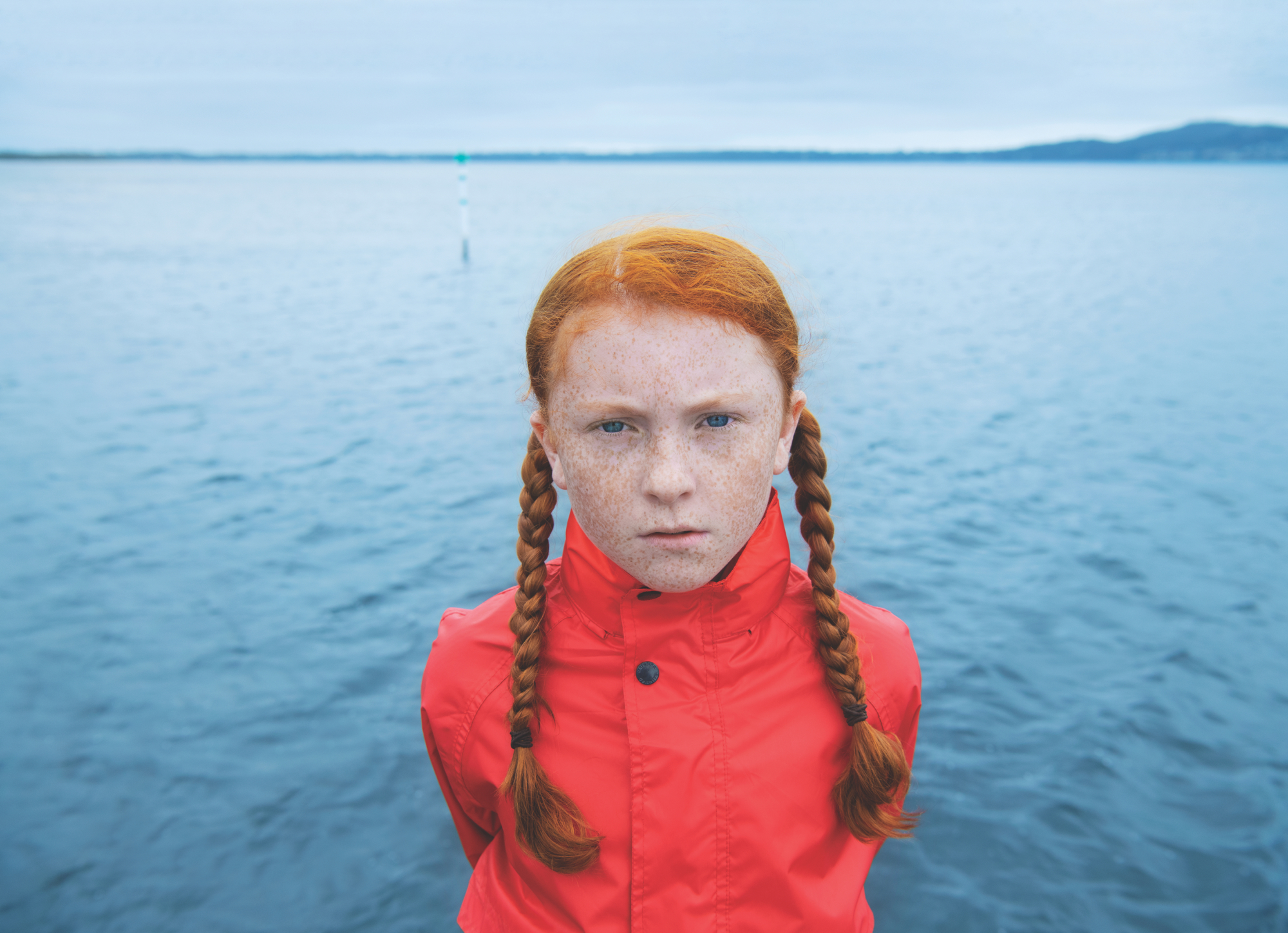With its protagonist hovering between twelve and thirteen, H Is for Happiness (John Sheedy, 2019) is often described as a coming-of-age film, but is actually something quite other. Its narrative offers its optimistic heroine the chance to contemplate puberty and then choose to return to the childhood she missed as a result of a family tragedy and parental neglect. With its representation of adults as ineffective and inadequate, H Is for Happiness casts doubt on the family ‘project’, highlighting the vulnerability of children. In the generically appropriate happy ending, the family has been re-established and the irrepressible protagonist’s childhood, reinstated; but the resolution bears with it an otherworldliness that places family happiness in the realm of fairytale.
Adapted from Barry Jonsberg’s bestselling 2013 young adult novel My Life as an Alphabet, H Is for Happiness tells the story of Candice Phee (Daisy Axon), a bullied outsider whose equanimity in the face of the sneers and intimidation meted out by her peers is an indication of the far greater impact of the debilitating emotional neglect she faces at home. Not only does Candice have to grapple with the death of her baby sister, Sky, from SIDS, she is also dealing with the impact of a pointless family feud, her mother’s (Emma Booth) depression and her father’s (Richard Roxburgh) detachment. In facing these challenges, she has chosen to arm herself with a carapace of good cheer along with a determination to build a better life for herself and her family. The friendship of new classmate Douglas Benson From Another Dimension (Wesley Patten) becomes an opportunity to reclaim the human and emotional connection that disappeared from her life with the death of her sister, albeit one that serves as a further reminder of the pitfalls of family life.
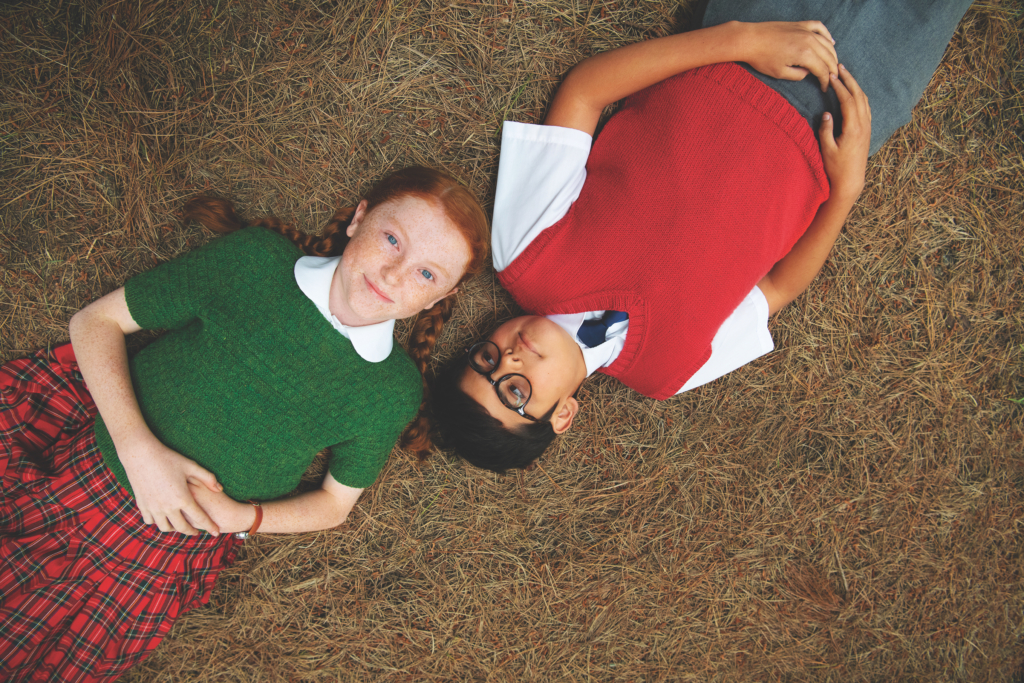
Screenwriter and producer Lisa Hoppe developed the project from scratch, seeing in Jonsberg’s novel the makings of the kind of small live-action family feature that she considered to be missing from the Australian market.[1]Andrew F Peirce, ‘Interview with H Is for Happiness Writer Lisa Hoppe’, The Curb, 30 December 2019, <https://www.thecurb.com.au/interview-h-is-for-happiness-writer-lisa-hoppe/>, accessed 18 May 2020. Certainly, the recent success of Oddball (Stuart McDonald, 2014)and Paper Planes (Robert Connolly, 2014) proved that there is an audience – particularly in Australia – for the kind of film Hoppe envisaged. Indeed, Connolly expressed a similar view that his film was plugging a gap, though he was more explicit than Hoppe about his film being part of a nation-building process relating to telling Australian stories that Australian children could engage with.[2]Karl Quinn, ‘Why Robert Connolly Hopes His Kids’ Film Paper Planes Will Take Flight’, The Sydney Morning Herald, 9 January 2015, <https://www.smh.com.au/entertainment/movies/why-robert-connolly-hopes-his-kids-film-paper-planes-will-take-flight-20150107-125oep.html>, accessed 18 May 2020. Although Hoppe talks about her determination that the H Is for Happiness story be understood as uniquely Australian in terms of ‘the dimensions of the relationships’,[3]Lisa Hoppe, quoted in Claire Hanson, ‘A Is for Albany’, Fabric Quarterly, 5 January 2019, <https://fabricquarterly.com.au/2019/01/a-is-for-albany/>, accessed 18 May 2020. the impetus for the project was less the building of national culture than the screenwriter’s affection for live-action family films, the ‘human level’[4]Hoppe, quoted in Peirce, op. cit. issues they navigate and their capacity to offer a multi-generational viewing experience:
There is a clear audience for the film. It is a family audience. I remember with my kids, one of the best activities they could do as a group and keep out of trouble – as you didn’t want them wandering around the malls – was to go to the cinema and have a lovely shared experience. I think this film will meet that audience and an audience of parents and grandparents taking slightly younger kids.[5]Hoppe, quoted in Hanson, op. cit.
Candice’s single-minded pursuit of a better life, expressed in the film’s ‘lollipop look’, is contrasted with her parents’ surrender to unhappiness.
This invites questions regarding the address of this kind of cross-generational film, drawing attention to the slipperiness of the family film as a genre, with its promise to entertain adults as well as the young people who are the ostensible target audience. In a 1995 essay, scholars Cary Bazalgette and Terry Staples bravely drew a (much-critiqued[6]Bazalgette and Staples’ definition has been critiqued for oversimplifying the complex and multifaceted object of their study. For example, Ian Wojcik-Andrews comments, ‘Any attempt to universalize children’s cinema, a children’s film, or the nature of the child viewer, only reveals more closely the contradictions in which children’s cinema finds itself situated.’ Wojcik-Andrews, Children’s Films: History, Ideology, Pedagogy, Theory, Garland Publishing, New York & London, 2000, p. 19.) distinction between the children’s film and the family film, arguing that the latter had its roots in the Hollywood economy as part of a strategy of reaching a broader audience. For Bazalgette and Staples, the family film typically includes ‘well-known adult stars to bring in the audience’ and a greater focus on the challenges of ‘coping with kids’ than the problems of children or young people. In contrast, the children’s film privileges the child’s point of view in order to ‘foreground the terms of coping with adults, or coping without them’.[7]Cary Bazalgette & Terry Staples, ‘Unshrinking the Kids: Children’s Cinema and the Family Film’, in Bazalgette & David Buckingham (eds), In Front of the Children: Screen Entertainment and Young Audiences, British Film Institute, London, 1995, pp. 95–6. Such generalisations are always debatable, but in this case draw attention both to the impressive line-up of adult stars in H Is for Happiness – Roxburgh, Booth, Joel Jackson, Deborah Mailman and Miriam Margolyes – and to the unequivocal positioning of adults as the problem in the narrative, with Candice having to cope with the ever-present grief of her parents and the emotional absence that this causes. Whether or not this makes H Is for Happiness a children’s film is beside the point; rather, Bazalgette and Staples’ distinction is useful in the way it draws attention to the centrality of Candice’s perspective, while highlighting the distance maintained between the audience and the adult characters. Miss Bamford (Margolyes), the only adult character who doesn’t fit into this framework, could be described as a ‘child at heart’, and shares an affinity with Candice through also being the target of the class bully.
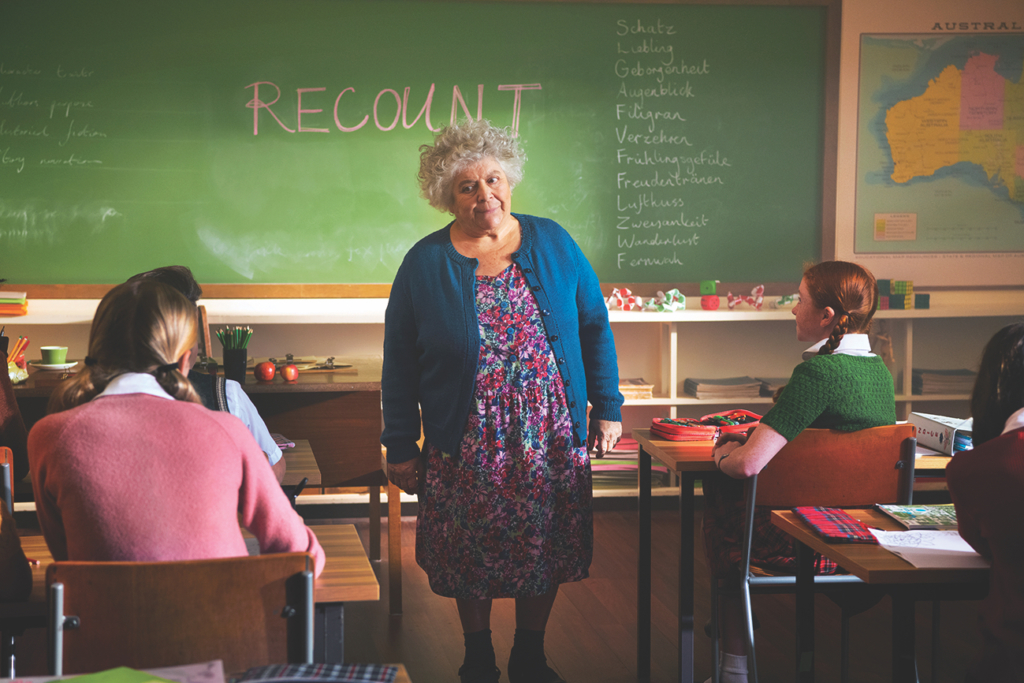
The narrative in My Life as an Alphabet is presented from Candice’s point of view, through internal monologue and a series of hilarious letters she sends to her unresponsive pen pal in New York. In H Is for Happiness, voiceover is one of the devices used to create a similarly intimate connection with Candice’s inner life and her unique perspective: ‘I would have to be living in a lead-lined coffin not to realise everyone is miserable. Maybe I can do something about it.’ However, the viewer’s connection to Candice’s worldview is also built through the heightened register of the film’s visual style. The fantastically bright colour palette, patterns, centred framing and one-point perspective counter the shadowy world occupied by Candice’s parents. This process of representation is not so much about communicating a child’s perception of the world or Candice’s innate positivity but, rather, has the purpose of illustrating her tenacious commitment to building (or retrieving) the family happiness that she believes is her birthright. The symmetrical composition of the shots and the recurring patterns and colour motifs illustrate Candice’s desire for order and predictability in the context of the unpredictability and emotional turmoil of her family. Virtually every review of H Is for Happiness points to the debt its visual style owes to Wes Anderson’s distinctive aesthetic;[8]See, for example, Sarah Ward, ‘H Is for Happiness: Melbourne Review’, Screen Daily, 10 August 2019, <https://www.screendaily.com/reviews/h-is-for-happiness-melbourne-review/5141863.article>; and Alissa Simon, ‘H Is for Happiness: Film Review’, Variety, 23 February 2020, <https://variety.com/2020/film/reviews/h-is-for-happiness-review-1203512460/>, both accessed 18 May 2020. and, as in Anderson’s films, the distinctive shot composition and colour palette draw attention to form and narrative artifice. Likewise, the nostalgic production and costume design that imbues H Is for Happiness with a yearning for an indeterminate past brings to mind a similarly unspecific ‘pastness’ in films by Anderson such as Moonrise Kingdom (2012) and The Grand Budapest Hotel (2014). At the same time, whereas Anderson’s aesthetic creates a distance between the viewer and his alienated characters, in H Is for Happiness the style is aligned with Candice’s perspective and her resolute commitment to family contentment. The hand-knitted pullovers, floral frocks, chalkboards, mismatched china, heritage shopfronts and record players communicate Candice’s desire to retrieve the happiness that has been lost and build a different future for her family.
Candice’s single-minded pursuit of a better life, expressed in the film’s ‘lollipop look’,[9]Luke Buckmaster, ‘H Is for Happiness Review – Emotional Affairs of Adults Seen Through a Bright, Childlike Lens’, The Guardian, 9 February 2020, <https://www.theguardian.com/film/2020/feb/09/h-is-for-happiness-review-emotional-affairs-of-adults-seen-through-a-bright-childlike-lens>, accessed 18 May 2020. is contrasted with her parents’ surrender to unhappiness. For instance, when asked by Candice to tell her ‘everything’ about her birth, her mother produces a narrative empty of affection and of any of the loving detail or personal acknowledgement a child might expect to hear: ‘You came into this world accompanied by pain, blood and tears.’ This response is expressed in the mise en scène: Candice peeps into the dark blue light of the bedroom through a crack in the door, and then makes her way slowly across the space between her and the small figure of her mother, dwarfed by the bed and its puffy quilt, pillows and cushions. After an abrupt cut, Candice takes up the conversation with her father in his shed, where he has retreated into an alternative world of computer programming; he barely turns away from the screen as he recollects with bitterness that, while he missed Candice’s birth, his estranged brother was there. The saturated hues, playful patterns and cartoonish vignettes that accompany Candice as she engages with the outside world are not completely absent from her home life, but are muted and intermittent, as is the attention of her parents.
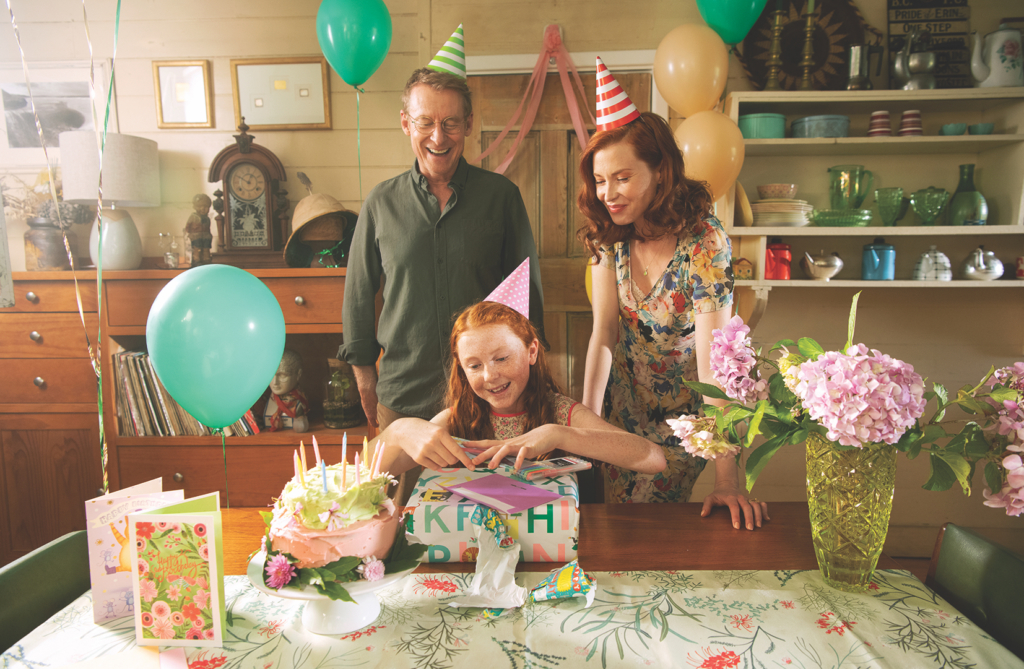
It is not unusual for films for young people to employ a fantastical or cartoonish visual style, but the juxtaposition of the colourful and stylised aesthetic with the high-stakes subject matter in H Is for Happiness creates challenges relating to tone. Tone relates to what is communicated to the audience about story and character (in contrast to what is communicated within the diegesis about mood), and in the context of the family movie requires careful management. In this case, director Sheedy sought to create a tonal ‘balance between drama and comedy’, drawing from what he had learned as a theatre director experienced in productions targeting families and young people: ‘Even though Happiness is unashamedly a feel-good film, you can’t feel good the whole way through. The audience has to believe that they’ve earned it.’[10]John Sheedy, quoted in ‘H Is for Happiness – Q&A Director John Sheedy’, Melbourne International Film Festival website, 9 July 2019, <http://miff.com.au/blog/view/4392/qa-with-h-is-for-happiness-director-john-sheedy>, accessed 18 May 2020. Along with the tragedy and dysfunction that motivate Candice’s happiness project, the narrative has an unpredictability that is sufficiently unsettling to build genuine doubt that the anticipated utopian ending will kick in and a resolution will be reached. In one brief scene, when Candice, full of frustration at her parents’ unyielding grief, begs her mother to accept Sky’s death, her mother throws a teapot at her. It misses; but the shard that Candice removes from her neck and the image of the fragments at her feet (shot using one-point perspective) offer both a vivid image of Candice’s broken family and a momentary – and deliberate – tonal rupture.
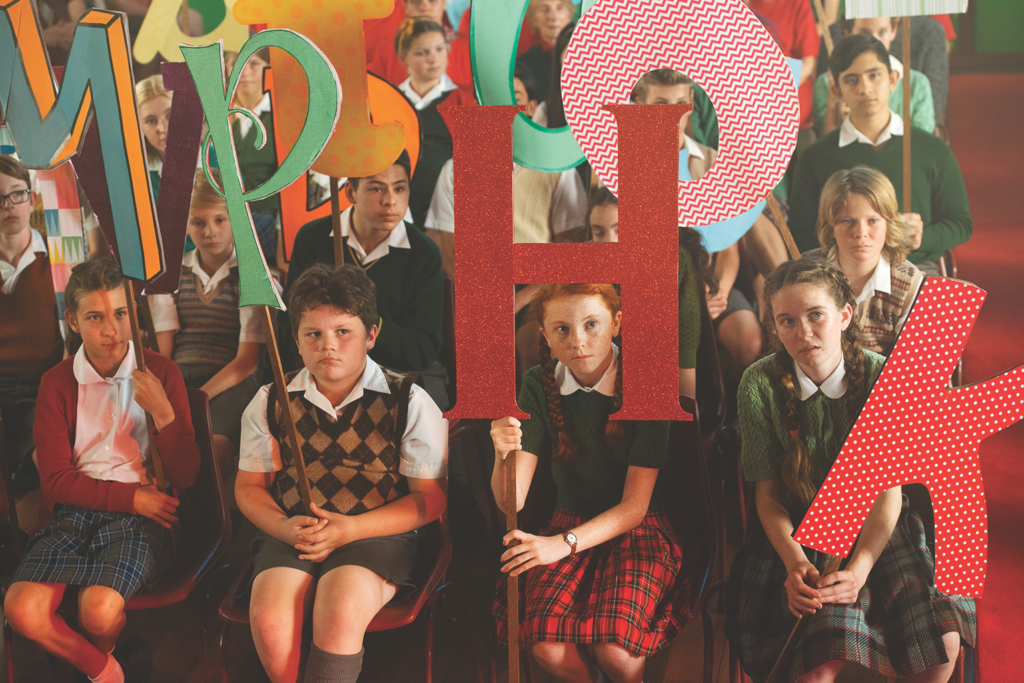
Also fascinating in terms of tonal complexity is the representation of Candice’s plan to use her thirteenth birthday to bring her father and uncle together by compelling them to join forces to save her from drowning. Instead, in a chapter of accidents and general clumsiness, they bash heads and have to be rescued, while Candice’s mother faints. Candice’s voiceover (‘O is for oblivion: they say that when you’re dying, your whole life flashes before your eyes’) is delivered in her characteristic upbeat register. But the shot of her as a tiny figure in red, suspended in a dark blue expanse and lit ethereally from above, is a powerful image of isolation. In keeping with Sheedy’s carefully calibrated tonal balance, the scene moves at a rapid pace, and tragedy is averted when Candice deploys the pneumatic breasts engineered by Douglas and is propelled to the surface. That it is his invention (and birthday present) that saves her, and he who dives in and pulls her out of the water, is further confirmation that her family cannot give her the support she craves. Douglas and Candice connect as outsiders finding acceptance in each other’s company, yet Douglas also functions as Candice’s alter ego: where she is striving to get closer to her parents and rebuild the family that she has lost, he regards his attentive and anxiously loving mother as a facsimile of the true parent he believes to exist in another dimension. Just as he supposes there is another life that he could be experiencing elsewhere, so too is Candice aware of an alternative, happier life she might have been living.
While Douglas sees his life as science fiction, his role in the narrative is drawn from fairytale; he is what folklorist Vladimir Propp describes as a ‘magical helper’.
Candice describes herself as a literalist, and has no truck with the figurative world of storytelling, choosing instead to read and consult the dictionary. In her damaged and uncommunicative household, it is up to her to find and speak the right words to break the spell that has been cast over her family. However, it eventuates that Douglas is the one with the needed vocabulary: the language of science fiction. His theories embracing change and infinite possibility kickstart Candice’s father’s creative ambition, setting in train the events that lead to the final resolution. While Douglas sees his life as science fiction, his role in the narrative is drawn from fairytale; he is what folklorist Vladimir Propp describes as a ‘magical helper’,[11]Vladimir Propp, Morphology of the Folktale, 2nd edn, University of Texas Press, Austin, TX, 2003 [1968], p. 82. a role that is obliquely prepared for in the first act when he takes Candice into the forest and introduces her to a mysterious white pony that will also figure in the denouement. As well as preparing the way for a fairytale ending to Candice’s story, these narrative elements draw on the forest as a liminal space associated with developing female sexuality, inviting comparisons with another recent film about an adolescent’s fantasy life, Girl Asleep (Rosemary Myers, 2015).[12]For more on this film, see Elizabeth Flux, ‘Dream Sequence: Rosemary Myers’ Girl Asleep and Cinematic Coming of Age’, Metro, no. 191, Summer 2017, pp. 6–13. Subsequently, this is where Douglas pledges his love and Candice has her first kiss, but also where Douglas risks death, jumping from the top of a tree in a desperate attempt to return ‘home’.
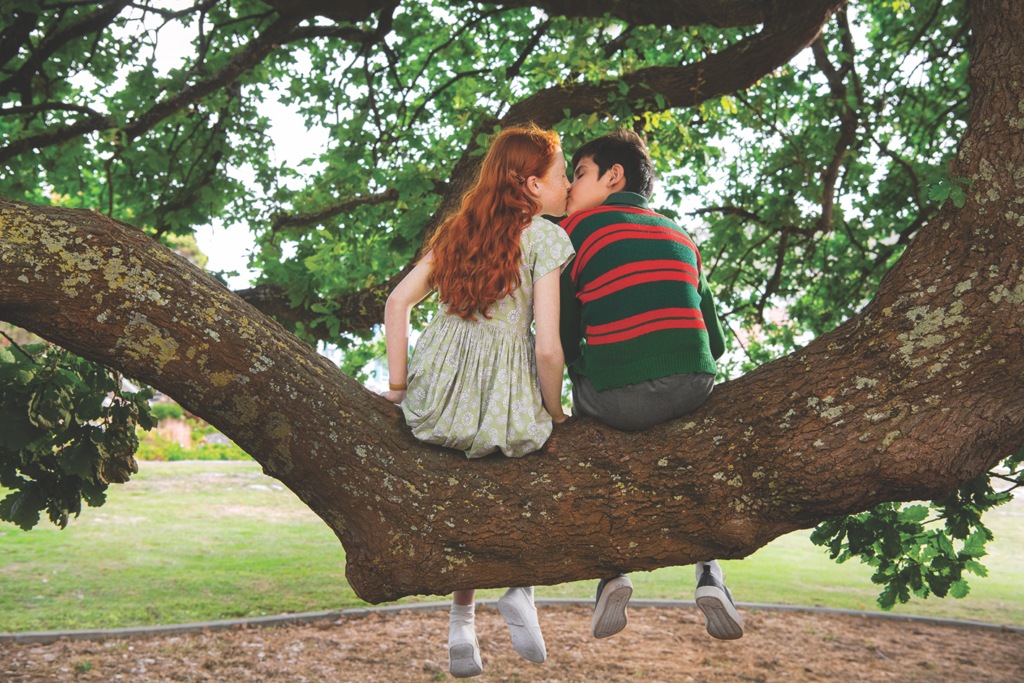
The feel-good climax of the story involves Candice and Douglas, in the guise of Dolly Parton and Kenny Rogers, delivering a lip-synced rendition of ‘Islands in the Stream’ to a school audience of students and parents. Inspired by Candice’s mother’s lost love of country music and the inflatable breasts that played such a prominent role on her birthday, this performance is the culmination of Candice’s pursuit of happiness. It has a liberating silliness that includes some not-so-magical pony excrement and the exuberant return to childhood indicated by the speedy and noisy deflation of Candice’s breasts when she is hugged by Miss Bamford.
In the final scene, the vibrant colour scheme of ‘boiled lollies or rainbow-coloured cupcakes’[13]Buckmaster, op. cit. has given way to an otherworldly palette of deep blues and greens, and the Phee backyard has been transformed into an enchanted landscape of coloured lights and paper lanterns. Candice’s family has been restored: her father is energised by his new project, her mother is emerging from the depression that has engulfed her, the feud between her father and his brother (Jackson) has been resolved, her baby sister looks down on them as a star in the night sky, and Candice can just be an ordinary kid, hanging out in slippers and green flannelette pyjamas. The narrative concludes with Candice addressing the audience and offering reassurance that while ‘families are fragile […] we’ll be okay’. The transformation is so profound that it is as if the family has travelled to the kind of alternate dimension that Douglas believes to be the source of authentic family happiness, and that has also captured the imagination of Candice’s father. It is a beautiful tableau that leaves viewers to question whether this final scene provides the ‘reaffirmation of “family”’[14]Noel Brown, The Hollywood Family Film: A History, from Shirley Temple to Harry Potter, I.B.Tauris, London & New York, 2012, pp. 2–3. at the heart of the family film, or presents such happy endings as a fantasy.
Endnotes
| 1 | Andrew F Peirce, ‘Interview with H Is for Happiness Writer Lisa Hoppe’, The Curb, 30 December 2019, <https://www.thecurb.com.au/interview-h-is-for-happiness-writer-lisa-hoppe/>, accessed 18 May 2020. |
|---|---|
| 2 | Karl Quinn, ‘Why Robert Connolly Hopes His Kids’ Film Paper Planes Will Take Flight’, The Sydney Morning Herald, 9 January 2015, <https://www.smh.com.au/entertainment/movies/why-robert-connolly-hopes-his-kids-film-paper-planes-will-take-flight-20150107-125oep.html>, accessed 18 May 2020. |
| 3 | Lisa Hoppe, quoted in Claire Hanson, ‘A Is for Albany’, Fabric Quarterly, 5 January 2019, <https://fabricquarterly.com.au/2019/01/a-is-for-albany/>, accessed 18 May 2020. |
| 4 | Hoppe, quoted in Peirce, op. cit. |
| 5 | Hoppe, quoted in Hanson, op. cit. |
| 6 | Bazalgette and Staples’ definition has been critiqued for oversimplifying the complex and multifaceted object of their study. For example, Ian Wojcik-Andrews comments, ‘Any attempt to universalize children’s cinema, a children’s film, or the nature of the child viewer, only reveals more closely the contradictions in which children’s cinema finds itself situated.’ Wojcik-Andrews, Children’s Films: History, Ideology, Pedagogy, Theory, Garland Publishing, New York & London, 2000, p. 19. |
| 7 | Cary Bazalgette & Terry Staples, ‘Unshrinking the Kids: Children’s Cinema and the Family Film’, in Bazalgette & David Buckingham (eds), In Front of the Children: Screen Entertainment and Young Audiences, British Film Institute, London, 1995, pp. 95–6. |
| 8 | See, for example, Sarah Ward, ‘H Is for Happiness: Melbourne Review’, Screen Daily, 10 August 2019, <https://www.screendaily.com/reviews/h-is-for-happiness-melbourne-review/5141863.article>; and Alissa Simon, ‘H Is for Happiness: Film Review’, Variety, 23 February 2020, <https://variety.com/2020/film/reviews/h-is-for-happiness-review-1203512460/>, both accessed 18 May 2020. |
| 9 | Luke Buckmaster, ‘H Is for Happiness Review – Emotional Affairs of Adults Seen Through a Bright, Childlike Lens’, The Guardian, 9 February 2020, <https://www.theguardian.com/film/2020/feb/09/h-is-for-happiness-review-emotional-affairs-of-adults-seen-through-a-bright-childlike-lens>, accessed 18 May 2020. |
| 10 | John Sheedy, quoted in ‘H Is for Happiness – Q&A Director John Sheedy’, Melbourne International Film Festival website, 9 July 2019, <http://miff.com.au/blog/view/4392/qa-with-h-is-for-happiness-director-john-sheedy>, accessed 18 May 2020. |
| 11 | Vladimir Propp, Morphology of the Folktale, 2nd edn, University of Texas Press, Austin, TX, 2003 [1968], p. 82. |
| 12 | For more on this film, see Elizabeth Flux, ‘Dream Sequence: Rosemary Myers’ Girl Asleep and Cinematic Coming of Age’, Metro, no. 191, Summer 2017, pp. 6–13. |
| 13 | Buckmaster, op. cit. |
| 14 | Noel Brown, The Hollywood Family Film: A History, from Shirley Temple to Harry Potter, I.B.Tauris, London & New York, 2012, pp. 2–3. |
